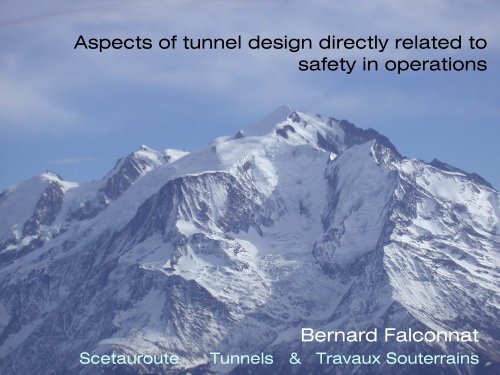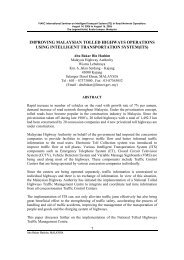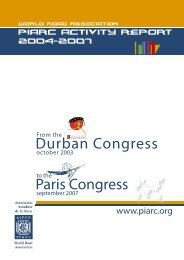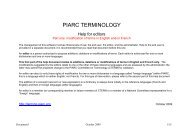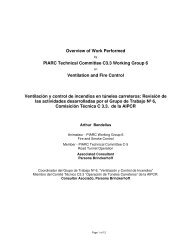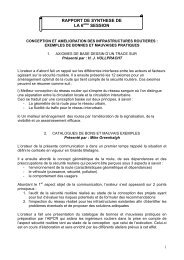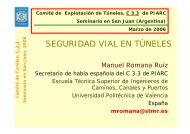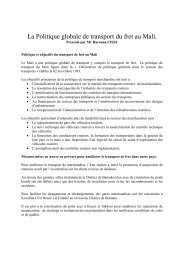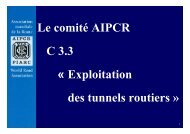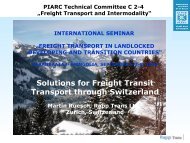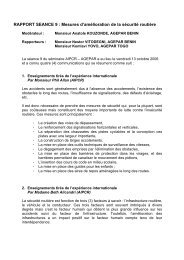bases of experience
bases of experience
bases of experience
You also want an ePaper? Increase the reach of your titles
YUMPU automatically turns print PDFs into web optimized ePapers that Google loves.
Aspects <strong>of</strong> tunnel design directly related to<br />
safety in operations<br />
Bernard Falconnat<br />
Scetauroute Tunnels & Travaux Souterrains
tunnels are complex systems<br />
tunnels are become a more & more complex<br />
and involve following disciplines<br />
geology, geotechnic, soil and rock mechanics<br />
civil work and structure<br />
more and more complex operating equipment<br />
ventilation<br />
air pollution - environment<br />
safety<br />
operation and training<br />
San Juan Seminar - 29th & 30th <strong>of</strong> March 2006 2
tunnels are complex systems<br />
tunnels are also expansive<br />
construction costs : one time<br />
operating costs : all the tunnel live (higher than<br />
construction)<br />
value engineering and optimisation process<br />
from the beginning <strong>of</strong> the design<br />
a cross analysis <strong>of</strong> all topics mentioned above to:<br />
optimise the alignment and length pr<strong>of</strong>ile<br />
• geology – ventilation – tunnel traffic capacity …<br />
optimise the functional cross section<br />
• excavation cost …<br />
guarantee a high safety level<br />
San Juan Seminar - 29th & 30th <strong>of</strong> March 2006 3
tunnels are complex systems<br />
value engineering & optimisation process (follow)<br />
ventilation system and escape routes are essential<br />
parts in this process<br />
this process may reach 15% <strong>of</strong> capital cost without<br />
to reduce the quality, comfort and safety level<br />
my presentation will focus on<br />
ventilation<br />
escape routes<br />
tunnels in sever mountainous conditions<br />
San Juan Seminar - 29th & 30th <strong>of</strong> March 2006 4
Ventilation
Art Bendelius will make a presentation<br />
concerning<br />
ventilation system<br />
fire and smoke control<br />
ventilation<br />
my presentation will focus on some particular<br />
aspects<br />
San Juan Seminar - 29th & 30th <strong>of</strong> March 2006 6
asic observations<br />
ventilation target<br />
fire fighting team are not able to intervene, if all the<br />
organisation is efficient (detection – alarm –<br />
mobilisation – transport to the site)<br />
in less than 5 to 10 mn for dedicated team on the site<br />
in less than 15 mn (much more if fire brigade is far<br />
away) for fire brigades out <strong>of</strong> the site<br />
after starting <strong>of</strong> a fire<br />
users have approx. 15 mn to save himself<br />
San Juan Seminar - 29th & 30th <strong>of</strong> March 2006 7
that means<br />
ventilation target<br />
the all information system (equipment – safety<br />
procedure - operator) has to inform very quickly the<br />
users trapped in tunnel<br />
users must be in condition <strong>of</strong> self rescue without to<br />
wait on intervention teams<br />
leaving their vehicles<br />
using eventually the extinguishers<br />
heading to escape routes or safety recesses<br />
but for that, they:<br />
o have to be aware <strong>of</strong> the danger<br />
o need to know the basic safety equipments & the<br />
attitude to follow toward a fire<br />
San Juan Seminar - 29th & 30th <strong>of</strong> March 2006 8
that means<br />
ventilation target<br />
safety equipments <strong>of</strong> the tunnel have to be<br />
designed and managed to allow the self saving <strong>of</strong><br />
the users immediately after the fire start<br />
stakes for the all ventilation system<br />
quick, efficient and reliable fire detection<br />
operating procedures for a quick switch on <strong>of</strong><br />
ventilation system<br />
efficient smoke control:<br />
• avoid smoke spreading (bi-directional or urban tunnel)<br />
• keep layering – high-performance & focused extraction<br />
to make users in condition to reach escape equipments<br />
San Juan Seminar - 29th & 30th <strong>of</strong> March 2006 9
ventilation concept<br />
ventilation concept<br />
must fulfil the stakes above<br />
has to be adapted to particular tunnel conditions<br />
urban or not (risk <strong>of</strong> jam or not)<br />
bi-directional or uni-directional (one or two tubes)<br />
traffic level - % <strong>of</strong> lorries – hazard goods transport<br />
particular climatic conditions<br />
operating and rescue organisation<br />
eventually environmental conditions at portal<br />
to the safety level required<br />
standards and regulation<br />
result <strong>of</strong> the risks and danger analysis<br />
o essential to carry out risk analysis & preliminary emergency<br />
response plan at the very beginning <strong>of</strong> the design<br />
San Juan Seminar - 29th & 30th <strong>of</strong> March 2006 10
ventilation system<br />
has usually a considerable impact on<br />
the functional cross section<br />
size <strong>of</strong> the cross section<br />
additional structures like<br />
ventilation design<br />
• building at portals – event. stacks for pollution dilution<br />
• underground caverns - ventilation shafts<br />
• ventilation ducts<br />
energy supply and distribution<br />
on construction costs and then operating costs<br />
o optimisation <strong>of</strong> ventilation system is <strong>of</strong>ten an important target<br />
involving: tunnel geometry – ventilation & safety concept<br />
San Juan Seminar - 29th & 30th <strong>of</strong> March 2006 11
mountain tunnels ventilation<br />
particular conditions for long mountain tunnels<br />
bi-directional tunnel with an unique tube<br />
high percentage <strong>of</strong> HGV traffic<br />
medium daily traffic average volume (3.000 to<br />
10.000 veh/day) but with a fast growth<br />
difficult access conditions due to altitude<br />
difficult climatic conditions – avalanches risk<br />
rare opportunity to build shafts due to overburden<br />
<strong>of</strong>ten isolated, fare from reliable energy supply<br />
(when existing) – from fire brigade and any village<br />
San Juan Seminar - 29th & 30th <strong>of</strong> March 2006 12
mountain tunnels ventilation<br />
particular conditions relating to ventilation<br />
mountain crossed by the tunnel is a climatic barrier<br />
pressure difference between portals may be high,<br />
eventually very high<br />
700 to 800 Pa measured at Mont Blanc tunnel<br />
sure similar figures for the long tunnels under project<br />
for crossing the Andes<br />
natural air flow velocity in tunnel is close to 4m/s, but<br />
may reach 8 m/s<br />
means that after 1mn, smoke will be naturally spread<br />
on a length <strong>of</strong> more than 250 m<br />
natural air flow direction may also change<br />
San Juan Seminar - 29th & 30th <strong>of</strong> March 2006 13
mountain tunnels ventilation<br />
ventilation concept & design must tackle these<br />
particular conditions<br />
return <strong>of</strong> <strong>experience</strong> <strong>of</strong> Mont Blanc tunnel disaster<br />
usual ventilation systems are not able to face up to<br />
these conditions<br />
the air volume mass under motion is huge<br />
and cannot be managed only by some adjustment on<br />
injected or extracted air quantity<br />
the airflow control may be obtain only by applying<br />
forces with jet fans<br />
o only a mix system is able to face up to these particular<br />
conditions<br />
San Juan Seminar - 29th & 30th <strong>of</strong> March 2006 14
description <strong>of</strong> a mix system<br />
mountain tunnels ventilation<br />
injection <strong>of</strong> fresh air from air ducts (health condition)<br />
extraction <strong>of</strong> polluted air (health condition) and smoke<br />
extraction through remote and motorised dampers<br />
(spacing 100m), and an air duct<br />
management and control <strong>of</strong> the air flow (and corollary the<br />
smoke) with jet fans installed in vault<br />
such a system has been developed and installed in<br />
Mont Blanc tunnel after disaster<br />
numerous tests that have been done show<br />
efficient air flow control even with high pressure difference<br />
very good mastering <strong>of</strong> smoke layering<br />
San Juan Seminar - 29th & 30th <strong>of</strong> March 2006 15
mix ventilation system concept<br />
concept based on R&D since 1990<br />
manage the evolution <strong>of</strong> smoke<br />
maintaining the stratification<br />
stability <strong>of</strong> back layering<br />
concept <strong>of</strong> air flow critical velocity<br />
principles<br />
fire detection with redundant systems<br />
reduce air flow velocity to 0m/s at fire place<br />
confine the smoke & establish stratification<br />
full automatic regulation <strong>of</strong> ventilation<br />
San Juan Seminar - 29th & 30th <strong>of</strong> March 2006 16
mix ventilation system concept<br />
control <strong>of</strong> longitudinal smoke spread<br />
Jet fan<br />
Dampers: motorised &<br />
remote controlled<br />
V containment<br />
Smoke exhaust<br />
volume =2.S.V containment<br />
V containment<br />
San Juan Seminar - 29th & 30th <strong>of</strong> March 2006 17
mix ventilation system concept<br />
Mont Blanc fire test modelisation<br />
San Juan Seminar - 29th & 30th <strong>of</strong> March 2006 18
F rom 0 to 1450 m<br />
french side<br />
French Portal<br />
4 INDEPENDENT<br />
FRESH AIR DUCTS<br />
new Mont Blanc ventilation system<br />
From 1450 to 2900 m<br />
fr ench sid e<br />
1450m<br />
2900m<br />
1 SMOKE EXTRACTION GALLERY<br />
CONTINUOUS ON 11.6 KM<br />
3<br />
82.5 m /s<br />
4350m<br />
From 2900 to 4350 m<br />
fre nch side<br />
5800m<br />
From 4350 to 5800 m<br />
french side<br />
fresh air duct<br />
Middle<br />
<strong>of</strong> Tunnel<br />
116 motorised &<br />
remote-controlled<br />
dampers<br />
smoke exhaust duct<br />
San Juan Seminar - 29th & 30th <strong>of</strong> March 2006 19
new Mont Blanc ventilation system<br />
76 jet fans in the vault<br />
control the longitudinal draught<br />
reduce it to 0 m/s within 2 min (500 Pa)<br />
smoke extraction dampers spacing 100 m<br />
motorised & remote-controlled<br />
smoke extraction duct<br />
3 axial fans at both portals<br />
4 fans inside the duct to boost the pressure<br />
volume: 150 m3/s for a 600-m long section<br />
captors: opacity and anemometers<br />
San Juan Seminar - 29th & 30th <strong>of</strong> March 2006 20
2 plants with:<br />
new Mont Blanc ventilation system<br />
3 exhaust fans (1 stand by)<br />
5 fresh air fans (1 stand by)<br />
76 reversible jet fans<br />
San Juan Seminar - 29th & 30th <strong>of</strong> March 2006 21
mix system management<br />
management <strong>of</strong> mix system is complex<br />
numerous actions to be done on lot <strong>of</strong> equipments<br />
set to a ready state when a fire is suspected<br />
establish an initial numerical model according to the<br />
history before the fire started<br />
start and full management <strong>of</strong> the jet fans except those<br />
near the fire place<br />
start and management <strong>of</strong> exhaust fans<br />
for a moving fire, track the vehicle & adapt the<br />
ventilation, opening / closing dampers etc<br />
after vehicle is stopped, full regulation <strong>of</strong> the ventilation<br />
system<br />
operator is under stress and very busy<br />
San Juan Seminar - 29th & 30th <strong>of</strong> March 2006 22
mix system management<br />
fully automatic management required<br />
much more better efficiency to perform the system<br />
0 m/s air<br />
velocity after<br />
4mn<br />
(automatic)<br />
instead 17mn<br />
(manual)<br />
longitudinal air velocity (m/s)<br />
0 m/s<br />
4 mn<br />
automatic management<br />
3 m/s<br />
manual management<br />
time (second)<br />
San Juan Seminar - 29th & 30th <strong>of</strong> March 2006 23
fire tests<br />
mix system management<br />
numerous fires <strong>of</strong> 1 hour continuous power 15 MW<br />
various initial conditions & pressures<br />
excellent results<br />
reactivity & capacity<br />
<strong>of</strong> the system<br />
full control <strong>of</strong><br />
stratification during<br />
1 hour tests<br />
San Juan Seminar - 29th & 30th <strong>of</strong> March 2006 24
Escape routes
egulation – standards<br />
standards vary according to countries<br />
escape routes<br />
EU Directive has introduced new common<br />
European standard for Trans European Network<br />
obligation <strong>of</strong> escape route (max. spacing 500m) twin<br />
tubes tunnel<br />
ditto for bidirectional<br />
tunnels<br />
class I & class II<br />
no safety shelters<br />
without connection<br />
to an escape route<br />
daily traffic per lane length ><br />
> 9.000 > 500m<br />
4.500 < tunnel < 9.000 > 1 km<br />
2.000 < tunnel < 4.500 > 3 km<br />
500 < tunnel < 2.000 > 3 km<br />
< 500 > 10 km<br />
San Juan Seminar - 29th & 30th <strong>of</strong> March 2006 26
EU Directive (follow)<br />
escape route<br />
• parallel to the tube<br />
• direct gallery connections to outside<br />
usual spacing design<br />
twin tubes : 300 to 400 m<br />
escape routes<br />
single tube : according to country and cost <strong>of</strong><br />
connection gallery<br />
urban tunnels : usually 200 m (but <strong>of</strong>ten 150 m)<br />
lower spacing if needed by risk analysis conclusion<br />
• number <strong>of</strong> users to evacuate<br />
• evacuation flow rate according to geometric conditions<br />
San Juan Seminar - 29th & 30th <strong>of</strong> March 2006 27
escape routes design<br />
escape routes are costly and design has to<br />
achieve best concept optimisation<br />
twin tubes tunnel<br />
usual optimised<br />
solution is to build<br />
direct connection<br />
galleries between<br />
the both tubes<br />
cross galleries are very expensive in case <strong>of</strong> bad<br />
geotechnical and hydro geological conditions (sand<br />
& gravel under water table), that may require<br />
grouting or soil freezing<br />
San Juan Seminar - 29th & 30th <strong>of</strong> March 2006 28
escape routes design<br />
twin tubes tunnel in bad conditions<br />
then tunnel excavation is driven with a shield and a<br />
circular pr<strong>of</strong>ile<br />
lower part <strong>of</strong> the circular pr<strong>of</strong>ile may be used to install an<br />
escape route inside the pr<strong>of</strong>ile, avoiding the construction<br />
<strong>of</strong> any very expensive connection<br />
San Juan Seminar - 29th & 30th <strong>of</strong> March 2006 29
unique tube<br />
escape routes design<br />
several dispositions are possible according to<br />
geographic situation<br />
ground conditions<br />
construction methods<br />
San Juan Seminar - 29th & 30th <strong>of</strong> March 2006 30
escape routes design<br />
escape route to the valley<br />
by pass tunnel <strong>of</strong> a ski resort : length 2,9 km<br />
one unique tube in a first construction stage<br />
escape routes to the valley 100 to 150 m<br />
alignment has been designed to make escape route<br />
possible<br />
escape routes<br />
escape short shaft<br />
San Juan Seminar - 29th & 30th <strong>of</strong> March 2006 31
escape routes design<br />
escape route in a parallel gallery<br />
used generally when renovation and safety improvement <strong>of</strong> an<br />
existing tunnel<br />
for a new tunnel (even in good ground conditions), suppl. cost<br />
<strong>of</strong> approx. 12% in comparison with integrated escape gallery<br />
(new 9 km Pir Panjal tunnel in Kashmir)<br />
example renovation Maurice Lemaire 7 km length<br />
R = 2.60 m<br />
2.20<br />
AIR FRAIS<br />
3.00<br />
GAINE<br />
D'AIR VICIE<br />
Existing<br />
tunnel<br />
Smoke extraction<br />
San Juan Seminar - 29th & 30th <strong>of</strong> March 2006 32<br />
Transit<br />
escape<br />
shelters<br />
Escape<br />
gallery
escape routes design<br />
escape route included in the cross section<br />
principle is to used fresh air duct as escape route<br />
to construct safety transit shelters with connection to<br />
escape route<br />
San Juan Seminar - 29th & 30th <strong>of</strong> March 2006 33
escape routes design<br />
escape route included in the cross section (follow)<br />
safety transit shelters<br />
electric vehicle<br />
escape route<br />
San Juan Seminar - 29th & 30th <strong>of</strong> March 2006 34
escape routes design<br />
tunnel in s<strong>of</strong>t ground<br />
cross value engineering process gives a saving <strong>of</strong> 100M€<br />
by abandonment <strong>of</strong> parallel escape route and fully internal<br />
redesign <strong>of</strong> the cross section<br />
TUNNEL DE LEFORTOVO - MOSCOU<br />
COUPE SECTION COURANTE<br />
Date 22.03.2002<br />
Echelle : 1/50 (<br />
Feux d'arrêt clignotant<br />
Plots de balisage<br />
Conduits<br />
Trappe d'extraction<br />
250x650<br />
Gaine d'extraction<br />
Galerie technique<br />
Chemin câble BT<br />
Chemin câble TBT<br />
Chemin câble réseau<br />
Caniveau HT #1<br />
Détection incendie<br />
Accélérateur<br />
Conduite d'évacuation des eaux de drainage<br />
3.25 3.50<br />
TGBT<br />
Porte<br />
2%<br />
2.50<br />
4.00<br />
Trappe d'extraction<br />
1800x2000<br />
PMV PMV<br />
Câbles rayonnants<br />
Détection incendie<br />
Luminaire<br />
ACCIDENT ACCIDENT<br />
Galerie<br />
technique<br />
Chemin câble BT<br />
1.13<br />
2.00<br />
Galerie de<br />
secours<br />
2.58<br />
Haut parleur<br />
Luminaire<br />
4.50<br />
2.50<br />
3.50<br />
Galerie d'évacuation<br />
Luminaire<br />
Accélérateur<br />
S.O.S.<br />
Conduite humide<br />
Réseau incendie<br />
Caniveau HT #2<br />
Gaine d'extraction d'air<br />
Réservoir central<br />
Appareil d'éclairage<br />
Détection incendie<br />
Conduite séche<br />
Réseau de mousse<br />
Signalisation de sécurité et accès galerie<br />
Accès galerie + niche de sécurité<br />
Feux d'arrêt clignotant<br />
Plots de balisage<br />
San Juan Seminar - 29th & 30th <strong>of</strong> March 2006 35<br />
Caméra<br />
Caméra<br />
Conduits
escape routes design<br />
cut and cover escape in avalanches area<br />
escape route inside the cross section by widening the cross<br />
section<br />
escape tower<br />
escape transit shelters at bottom<br />
tower protected by earth dam<br />
evacuation through stairs with exit level used according to snow<br />
thickness<br />
possible use <strong>of</strong> the central duct for ventilation<br />
San Juan Seminar - 29th & 30th <strong>of</strong> March 2006 36
escape routes design<br />
signalling <strong>of</strong> the escape route and the access to<br />
escape is essential<br />
hand rail for the users<br />
guide rail for fire brigade<br />
beacons<br />
San Juan Seminar - 29th & 30th <strong>of</strong> March 2006 37
tunnels in sever mountainous conditions
sever mountainous conditions<br />
particular conditions as for example<br />
difficult access conditions due to altitude<br />
difficult climatic conditions<br />
avalanches risk at portal and along the access<br />
<strong>of</strong>ten isolated, fare from reliable energy supply (when<br />
existing) – from fire brigade and any village<br />
risk analysis and a preliminary safety response plan<br />
are mandatory<br />
before to start the design<br />
to evaluate the risks<br />
to choice design and operation concepts in order to<br />
mitigate the risks and make it acceptable<br />
San Juan Seminar - 29th & 30th <strong>of</strong> March 2006 39
some examples<br />
sever mountainous conditions<br />
difficult access conditions due to altitude<br />
possible overheating for HGV and then burning in the tunnel<br />
possible mitigations<br />
• heat control before to enter the tunnel<br />
• waiting parking in order to low the temperature<br />
heat scanner<br />
San Juan Seminar - 29th & 30th <strong>of</strong> March 2006 40
some examples<br />
difficult climatic conditions<br />
sever mountainous conditions<br />
efficient winter maintenance<br />
risk evaluation for break down energy supply<br />
emergency housing for people trapped<br />
avalanches risk at portal<br />
and along the access<br />
special protection structure<br />
remote preventive start <strong>of</strong><br />
avalanche : catex, gazex …<br />
particular safety procedures<br />
San Juan Seminar - 29th & 30th <strong>of</strong> March 2006 41
sever mountainous conditions<br />
some examples<br />
<strong>of</strong>ten isolated, fare from reliable energy supply<br />
reliability analysis <strong>of</strong> all energy supply system<br />
reinforcement or protection investigation<br />
dedicated generators<br />
far from fire brigade and any village<br />
mandatory to organise a dedicated team, to have<br />
own intervention means<br />
all these resources has to be sized according to the<br />
result <strong>of</strong> risk analysis and response plan<br />
results <strong>of</strong> this thinking process will be part <strong>of</strong> the<br />
action plan and base <strong>of</strong> design program<br />
San Juan Seminar - 29th & 30th <strong>of</strong> March 2006 42
Thank for your attention


